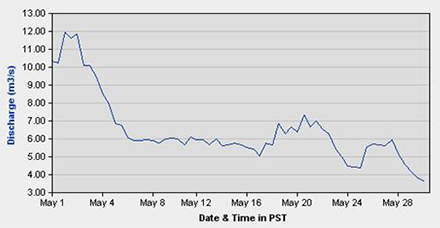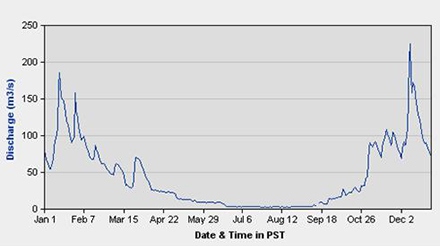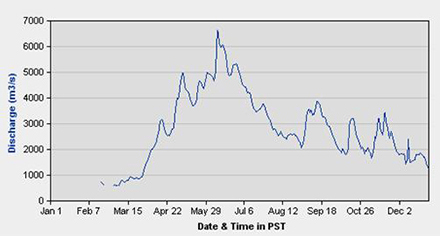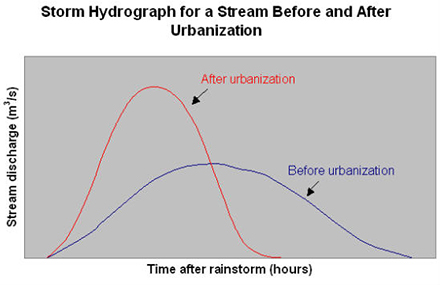How Does Water Move Through A Watershed
Overview
Every bit anyone who has lived near a river or stream knows, the character of the flowing h2o changes according to time of day, twelvemonth, season, and during extreme events such as floods and droughts. Watercourses may be a mere trickle at certain times, and a raging torrent at other times. The important betoken is that no stream or river is completely stable; equally in life, the only constant in a river or stream is change. This section concerns the variability of water flows in the watershed and how human developments alter this variability.
Despite the sometimes enormous magnitude of these changes, over the eons river systems achieve a balance with the surrounding landscape. The vegetation and animal life that is office of the system adapts to and thrives in the local conditions. Even plain catastrophic floods are part of a great cycle of cleansing and renewal. H2o flows in rivers and streams are closely connected with the function of other ecosystems such as forests and meadows, lakes, wetlands and marine shorelines.
Stream flows can exist significantly altered when rivers are dammed, when streams are channelized for better drainage of the land, when riparian vegetation is removed, and when the land in the watershed is modified, for example by urbanization that causes an increase in impervious surfaces. Although in some cases this alteration is necessary for benefits such equally hydropower generation, nutrient product, timber harvesting and economic development, many of the consequences have merely recently been recocognized. Some of the impacts on streams and rivers include pollution, excess erosion and/or sedimentation, increased flooding, falling water tables, habitat loss, and the collapse of some fisheries.
In order to preserve the function of streams and rivers, along with their valued products and services, we need to find better ways of working with these dynamic systems, and encouraging development that has a minimal affect on them. Understanding the importance of variability in flows is therefore necessary in order to reduce the deposition of natural h2o bodies.
How are stream flows studied?
Ane method of studying stream flows involves calculating the discharge of a detail stream or river. Discharge is the measure of the volume of water that passes a betoken in a given period of time, commonly noted in cubic metres per 2d, m3/southward (there are one thousand litres in a cubic metre). The discharge can exist obtained past a couple of different methods.
In the area-velocity method, the cross-exclusive expanse of the stream is adamant, and the velocity of the water is measured with a current meter, at regular intervals and depths across the stream. A Gurley meter, for instance, uses cups that rotate in the current and measures the revolutions per second. For streams modest enough for a person to wade across, the current meter can exist hand-held. For larger streams and rivers, it is suspended from a cable or bridge. The velocity of the water (measured in metres/second) is multiplied past the area (measured in square metres), to obtain the discharge (in metres3/second). The belch can exist calculated for different sections of the stream, and averaged. Automated instruments can continuously monitor stream discharge.
Discharge can also exist measured with weirs and flumes, structures that are placed across small streams and control the amount of water that flows through some opening; this allows like shooting fish in a barrel measurement. A mutual type is a Five-notch weir, a pocket-sized dam with a 5-shaped opening in the heart.
Once the discharge of a stream is measured, a hydrograph tin can be drawn. A hydrograph is substantially the "flow signature" of a stream, and measures the belch or the water level over fourth dimension. Hydrographs are very useful for characterizing streams and rivers, for instance to note how quickly they ascension in response to rain storms, or at what time of the year top flows occur. Beneath is an example of a hydrograph for Englishman River, about Parksville, for the month of May, 2004 (source: Environment Canada: Real Time Hydrometric Data).

Hydrograph for Englishman River for May, 2004
What natural factors influence stream flows?
The flows of rivers and streams differ co-ordinate to a number of factors:
- Climate (i.eastward. the long-term atmospheric condition trends of an expanse) determines: how much rain falls and at what times of the year; how much snowfall falls and when it melts; when and to what extent drought occurs; and if and when the stream freezes over.
- Topography and relief (i.e. the shape of the land and difference in meridian): streams that flow down steep terrain, with a sudden change in elevation, catamenia more quickly than those in flat valley bottoms. Streams that are surrounded by steep terrain also usually recharge with rainwater and snowmelt more quickly than streams in more flat country.
- The size of the watershed, as well equally the number of tributaries within information technology, affects the volume of water in a stream or river. A very big watershed, such as that of the Fraser River, can span a number of different types of landforms and ecosystems that touch the flows of the river in unlike means.
- Geology (the type and grapheme of stone and soil): this cistron determines how much rain water soaks into the ground, compared to the amount that flows beyond the surface. For example, in areas with a lot of exposed bedrock, much of the rainwater flows beyond the surface and quickly raises h2o levels in nearby streams. In areas with highly permeable soils, on the other manus, flows increase and decrease more gradually earlier and after a rainfall, due to the sponge-like nature of the surrounding soils. Geology also determines where the groundwater flows and how quickly it seeps into rivers equally baseflow.
- Vegetation soaks up water from the basis, and contributes to the ability of soils to soak up water, with its contribution of spongy organic textile (i.east. accumulations of dead leaves and woods litter). Therefore, areas with lush vegetation commonly experience more than gradual increases and decreases in water levels and discharge, since infiltration and evapotranspiration are increased (see besides The Water Cycle for explanations of these terms).
- Large woody debris, east.m. fallen copse, is very important in many streams for dissipating the energy of water flows, for creating pools and off-channel fish habitat, for capturing sediment and protecting stream banks. Removing this debris can increase flows and cause erosion.
- Storage capacity is provided past riparian zones (h2o-loving vegetation, saturated soils and their associated ecosystems), wetlands and lakes. Storage allows the organization to blot big volumes of rainfall and snowmelt without flooding.
A hydrograph depicts the "flow signature" of a particular river or stream, and tin can vary greatly depending on the above factors. For example, the Cowichan River, on Vancouver Island, experiences peak flows over the winter, in response to the wintertime rains in this office of the province. The Fraser River, on the other hand, experiences peak flows during the spring to early on summer, due to snowmelt in the interior mountains. These two hydrographs are shown below.

Hydrograph for Cowichan River, BC, 2003

Hydrograph for Fraser River, near Promise BC, 2003
Why is natural variation in flows important?
Plants and animals take evolved over the millennia to thrive in the natural cycles of high and depression flows that are particular to a local surface area. Until recently, river management has mainly focused on maintaining a minimum depression flow, with the goal of maintaining certain fish stocks. Unfortunately, experience is proving that streams and rivers are highly circuitous and cannot necessarily be managed for one species or homo value in isolation of other components of the organisation.
Naturally depression flows are necessary for insect breeding in the floodplain, to provide sheltered pools for juvenile fish and to allow floodplain vegetation to mature. Naturally loftier flows help to shape the channel, flush wastes and provide spawning cues for fish. Natural floods furnish floodplains with food-laden sediment, allow fish to admission shallow areas, and disperse the seeds and fruits of floodplain plants. These functions are summarized in the table beneath.
Loftier and low flows in themselves are non necessarily sufficient to maintain ecological functions in a stream. The timing, elapsing, frequency and magnitude of these events are also crucial. Variations in flows still occur in altered streams, for case when h2o is released or withheld from dams according to hydropower needs, or when runoff from impervious surfaces causes sudden high flows. Yet, in such cases the flow events occur at unnatural times and frequencies that do not necessarily benefit riparian ecosystems.
Tabular array 1. Functions of different naturally occurring flow levels in unaltered streams and rivers
| Extreme low flows (droughts) | Seasonal low flows | Seasonal high flows | Extreme high flows (floods) |
|---|---|---|---|
|
|
|
|
How practice people alter h2o flows?
Big Infrastructure & Water Works
Get-go centuries ago, people have sought to control the often destructive and unpredictable flows of large rivers. This endeavour became more than successful with more than powerful tools and technology. Some examples of deliberate alterations of stream and river flows include: dams used for hydroelectric power, irrigation and drinking h2o; dykes and levees congenital to protect human settlements along floodplains; channelization (widening, deepening and straightening) of rivers to facilitate shipping; ditching and drainage of depression-lying agricultural land for agriculture. These modifications have had enormous effects on watersheds, water supply and water flows (see More than Information).
Water Extraction
Other, more subtle modifications also impact water flows. When a lot of water is extracted from rivers or groundwater sources for irrigation and drinking, stream flows can be diminished. This is a big trouble in dry areas such as the Okanagan, and in rivers that take a high demand placed on them such as the Columbia River. Even some streams in the Victoria area, such as Millstream Creek, accept recently ceased to reach the sea at times during the summers. The effects of urbanization.
Impervious Surfaces
I of the most pressing bug in watersheds of the Victoria surface area is the effects of urbanization. When big natural storage areas such as wetlands and riparian zones are lost to evolution, rivers often become more "flashy." In other words, they respond more than chop-chop to increases and decreases in precipitation. This can lead to more than floods and cause harm to stream channels. Increases in impervious surfaces (i.e. paved roads, parking lots, building roofs) in urban areas in full general are also responsible for this outcome (see also Natural vs. urban watersheds). The hydrograph of a stream before and after urbanization reveals how impervious surfaces affect streams, equally shown in the diagram below.
H2o flows chop-chop off impervious surfaces, rather than percolating slowly into the ground as information technology would exercise in a natural watershed. Therefore, the discharge and water level in a stream increases suddenly. Since impervious surfaces do non let h2o storage, the levels too drop quickly. These sudden changes in discharge also indicate changes in the energy of a stream. The effect on the stream channel is similar to that of turning a firehose loose on your garden for short periods of time. Sudden torrents of water scour stream banks, causing erosion. The soils and sediment that are done into the water can smother fish spawning beds and other aquatic habitat, and degrade h2o quality and so that less vegetation and fewer aquatic animals tin can survive.

Groundwater
Another common consequence of urbanization is depleted groundwater. In natural watersheds, forest cover, riparian vegetation and permeable soils encourage much of the rain water to soak into the ground, where information technology contributes to groundwater reserves. Unlike surface water, groundwater is often very ho-hum-moving and requires years to centuries to replenish in one case it is depleted. These reserves are important drinking h2o sources in many areas. Groundwater besides maintains stream baseflow in the dry summer months, which is necessary to preclude streams from drying up, and nourishes riparian vegetation. Both sufficient stream menstruation and riparian vegetation are necessary to maintain freshwater ecosystems, which are equanimous of the interactions amid plants, invertebrates, fish, birds and mammals (meet Riparian Zones).
Large Woody Debris Removal
Removal of naturally occurring large woody debris (LWD), such as fallen copse, is a common consequence of urbanization. It is oftentimes removed in order to "clean upward" streams and in order to remove a perceived adventure to property. LWD is now recognized every bit an important component of many streams, as information technology helps to dissipate flows and provides fish habitat.
Flood Protection Walls
When watercourses are confined with dykes, levees and retaining walls, they are separated from their floodplains. Unremarkably, the floodplain helps to misemploy the energy of high flows by allowing the h2o to spread out over a shallow area, and helps to absorb and shop excess water. When buildings, roads and other structures are built in the floodplain, protective walls become necessary to prevent property damage due to floods. Withal, the increased stream energy is only transferred farther downstream, where information technology can cause serious damage to stream channels and adjacent belongings and habitat. Large floods sometimes even overtop these walls. A better option for protecting the function of the stream tin sometimes involve moving the dykes back and restoring at least some of the floodplain, while still retaining overflowing protection.
People who live along streams and lakes sometimes build retaining walls forth their property to protect the banks and shorelines from erosion. Paradoxically, these structures can actually increase erosion by redirecting water energy to the sides and base of the wall. Retaining walls also practice not accept any water storage capacity, compared to natural riparian vegetation; therefore, they contribute to the "flashy" flows described to a higher place in urbanization and impervious surfaces. In club to avoid the result of erosion in the kickoff place, it is generally more appropriate to place structures, roads and trails some distance dorsum from the water's edge, and to preserve or plant natural vegetation forth stream banks (run across shoreline and streamside development).
Consequences of Flow Alterations – a Modify in Thinking
Many of the problems relating to alterations of stream flows stem from a general objective that until recently has guided h2o direction: that is, to get the water off of the state as quickly equally possible. This thinking is understandable, in terms of a short-term strategy to avoid alluvion harm, just in the long term it may do more impairment than skilful. Shipping the water off the country, with vast networks of gutters, storm drains, culverts and drainage ditches, deprives both people and ecosystems of a most precious resources and has pb to a number of problems, such as:
- increased erosion and harm to stream channels, from high volumes of water flowing into natural water bodies
- property impairment and habitat loss, acquired past excessive erosion and sediment deposition
- greater amounts of chemicals, nutrients and bacteria flushed off agronomical and urban surfaces, into natural h2o bodies
- depleted groundwater, which is necessary for drinking, irrigation and to maintain stream flows during the summer
- increased financial costs related to maintaining and installing drainage systems and repairing flood damage
A shift in thinking is currently underway, whereby local governments and planners are treating stormwater as a resource rather than a liability. This approach is sometimes called "integrated stormwater management," since it combines the objectives of maintaining riparian ecosystems, protecting human being property, improving water quality and saving money. A diversity of techniques can be used to reduce human impacts on stream flows, while allowing for appropriate evolution and flood protection.
How tin human influences on h2o flows be reduced?
Generally, actions that restore the natural flow patterns in the watershed help to foreclose the problems outlined in the previous sections, and achieve the greatest success in stream and river restoration. Of grade, completely restoring such patterns may not be feasible in some highly altered rivers, for example those that are relied upon for major power generation or that are located within a big urbanized area. Notwithstanding, mimicking natural flows, even on a reduced scale, has many potential benefits for the function of riparian ecosystems. Here are some examples of possible methods to achieve this:
- Activities in the watershed that may touch stream flows must be advisedly planned, assessed and monitored, for example logging, new construction and agriculture. Appropriate prepare-backs from riparian zones and floodplains, and "all-time management practices" (BMPs), are ii tools that can be used to moderate homo impacts on stream flows.
- Storage capacity and infiltration of rainwater in the watershed tin can be increased by protecting natural forests, wetlands and riparian zones. This tin can even exist successful in urban or suburban areas; for example, these areas tin can exist combined with public green space and linear parks. Greater infiltration of rainwater in naturally vegetated areas reduces the volume that flows across impervious surfaces and subsequently disrupts stream flows.
- Where natural reservoirs and wetlands do not exist, constructed wetlands and stormwater detention ponds are sometimes constructive, both for water storage and to help treat polluted runoff from urban and industrial areas. Impervious surfaces in general can be limited and reduced with a wide range of alternative materials and practices (run into How can I aid reduce impervious surfaces?).
- Large woody droppings can be left in streams, where possible, to assist protect stream banks, misemploy the energy of high flows and provide habitat.
- Where appropriate, streams tin be reconnected with their floodplains, by removing and setting back dykes and h2o retaining walls.
- Native riparian vegetation can exist left in place or replanted, in order to assistance stabilize shorelines and streamsides, protect against erosion, help restore natural flows and increase water storage in these areas. This can even be done by individual owners of waterfront property (meet shoreline/streamside development for more tips).
- In rivers that are dammed, water releases and retentions tin can sometimes be timed to mimic natural flows, while notwithstanding serving human needs. Increasingly, dams are being decommissioned, where they accept outlived their usefulness, or where their negative consequences outweigh their benefits. This is a complex endeavor that requires interdisciplinary planning and cooperation (see "River Recovery: Restoring Rivers Through Dam Decommissioning" under Additional Information & Links > Websites).
Additional Information & Links
Websites
- Stormwater Management: Ministry of Water, Land and Air Protection
- Environment Canada Water Survey
- Stream Corridor Restoration: United states of america EPA
- Watershed Picket: Reports
- River Recovery: Restoring Rivers Through Dam Decommissioning
Manufactures
- Flows for Floodplain Forests (PDF)
- How Much Water Does a River Need? (PDF)
- Postel, S. and B. Richter. Rivers for Life, Managing H2o for People and Nature. Isle Press, Washington. 2003.
How Does Water Move Through A Watershed,
Source: https://www.crd.bc.ca/education/protection-stewardship/watersheds/watershed-basics/watershed-water-flows
Posted by: myersmarder.blogspot.com


0 Response to "How Does Water Move Through A Watershed"
Post a Comment